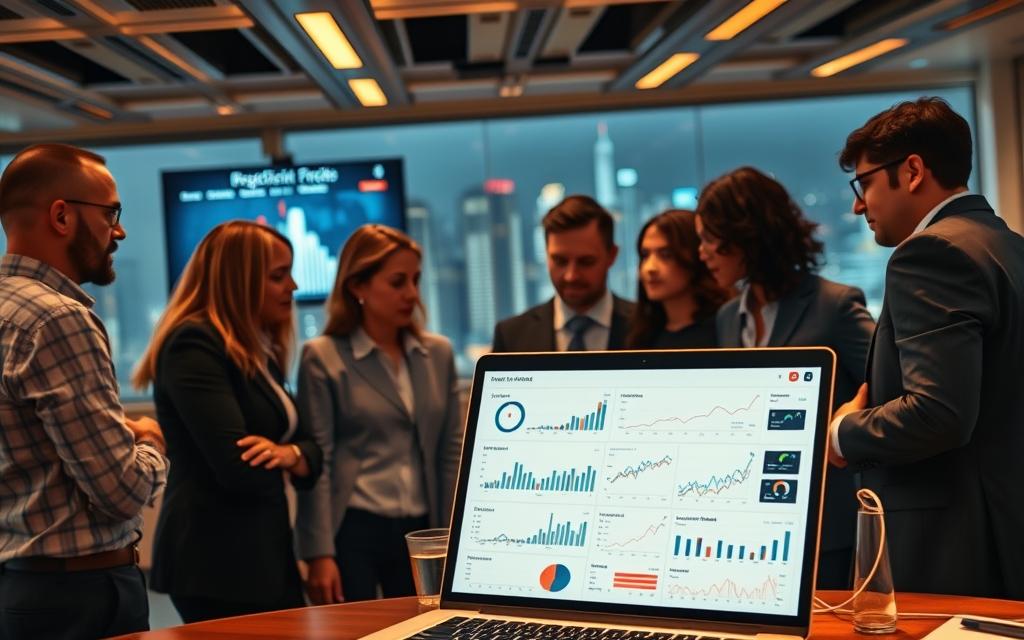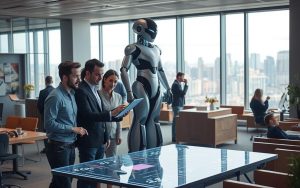Table of Contents
Organizations are rapidly embracing AI technologies, with adoption rates soaring to 72% according to McKinsey research. This transformation reshapes operations, boosts efficiency, and unlocks new opportunities across industries.
Market leaders demonstrate the power of intelligent tools. Amazon leverages machine learning to optimize logistics, saving millions in delivery costs. Walmart uses predictive analytics to streamline inventory, minimizing overstock expenses.
Generative AI now automates 40-50% of knowledge work, freeing teams for strategic tasks. The $1.3 trillion market impact reflects this seismic shift, blending human expertise with advanced technologies.
Workforce dynamics evolve as companies integrate these solutions. Training programs and adaptive strategies ensure smooth transitions, maximizing the benefits of digital transformation.
Introduction to AI in Business
From Turing’s early concepts to today’s cloud-powered tools, artificial intelligence reshapes industries. What began as theoretical research now drives real-world solutions, with 80,000 companies globally leveraging AI.
The Evolution of AI: From Concept to Business Tool
Alan Turing’s 1950 Turing Test sparked AI’s potential. Decades later, Apache Spark and Hadoop systems enabled large-scale data processing. Three key advancements fueled this shift:
- GPU breakthroughs: Accelerated deep learning, making complex algorithms feasible.
- Cloud computing: Allowed real-time analysis of massive datasets.
- Generative AI: Automates tasks, boosting productivity by 40% in sectors like logistics.
Why AI Adoption Is Accelerating
McKinsey’s 2023 report reveals 72% of firms now use artificial intelligence, up from 50% the prior year. Verizon notes small businesses doubled adoption to 39%, citing:
- 40% fewer errors in supply chains.
- Faster decision-making with machine learning-powered analytics.
Cloud platforms cut time-to-insight, while AI tools like ChatGPT democratize access. Executives report 75% optimism about AI’s ROI, signaling sustained growth.
How Are Businesses Helping with the Switch to AI?
Forward-thinking companies now prioritize AI integration, focusing on workforce development and tech upgrades. Strategic investments ensure seamless adoption, combining human expertise with cutting-edge tools.

Empowering Teams Through Upskilling
Verizon partners with AWS and Azure to reskill workers, reducing implementation hurdles. Bank of America’s “Erica” chatbot training protocol improved efficiency by 35%.
Salesforce’s Trailhead program certifies AI skills, while Gusto reports a 45% hiring boost for firms with upskilling initiatives. These efforts highlight the critical role of continuous learning.
Modernizing Infrastructure for AI
Cisco allocated $15M to redesign workspaces with AI-driven analytics. Walmart’s $500M warehouse robotics investment slashed logistics errors by 40%.
The AI infrastructure market grows to $2.6B, fueled by demand for scalable tools. Code Ninjas’ AI coding assistant exemplifies how small businesses leverage these advancements.
Automating Routine Tasks for Efficiency
Intelligent automation transforms mundane workflows into strategic assets. Leading companies now delegate repetitive tasks to AI, unlocking unprecedented productivity gains. From logistics to customer service, automation slashes costs and errors.
Examples of AI-Driven Automation
Amazon’s route optimization AI saves $300M yearly by minimizing delivery delays. DHL’s predictive maintenance system prevents fleet breakdowns, reducing costs by $100M annually.
Coca-Cola’s smart vending machines use AI to restock inventory proactively. This cuts downtime by 30% and boosts sales. In manufacturing, computer vision detects defects 63% faster than manual checks.
Cost Savings and Productivity Gains
Machine Learning accelerates invoice processing by 50%, while chatbots reduce call times by 70%. Forrester’s ROI calculator shows a 200% return on automation investments within two years.
UiPath and Automation Anywhere lead the RPA market, each offering unique tools to streamline operations. These platforms integrate seamlessly, enhancing AI operational efficiency across departments.
Leveraging AI for Data Analysis and Decision-Making
Modern enterprises unlock new potential through AI-driven data insights. These insights refine strategies, optimize operations, and fuel growth across industries. From retail to finance, intelligent analytics deliver precision at scale.
Big Data Processing with AI
Walmart improved inventory turnover by 30% using machine learning. JP Morgan’s Contract Intelligence (COIN) saves 360,000 lawyer hours annually by parsing contracts. Key technologies power these breakthroughs, including:
- TensorFlow/PyTorch: Credit risk models predict defaults with 95% accuracy.
- Cloud-native platforms: Process petabytes of data in real time.
Real-World Applications in Finance and Retail
Mastercard’s AI systems detect fraud with 90% accuracy, reducing losses. Sephora’s virtual artist boosted sales 35% by matching shades using computer vision.
Bloomberg’s GPT analyzes earnings reports in seconds, highlighting trends. SAS and Alteryx compete in predictive analytics, offering tools for demand forecasting. MIT studies show AI cuts retail forecasting errors by 50%.
These innovations prove AI’s role in shaping smarter decisions. By blending AI operational efficiency with human expertise, firms gain unmatched agility.
Enhancing Customer Experiences with AI
AI transforms customer interactions by delivering hyper-personalized experiences at scale. From curated playlists to instant support, intelligent tools bridge gaps between brands and audiences.

Personalization Through AI
Spotify’s Discover Weekly drives 30% engagement using social media listening and listening habits. Netflix’s $1B algorithm boosts retention by tailoring recommendations, proving ROI in content curation.
Zappos’ AI stylist lifts average order value by $45 through marketing-focused outfit suggestions. Forbes notes 71% of shoppers now demand such customization, pushing brands to adopt similar tools.
AI-Powered Customer Support
Bank of America’s Erica handles 2M daily queries, resolving 85% without human agents. KLM’s BlueBot slashes response times to 2 minutes, outperforming traditional email.
Starbucks’ Deep Brew optimizes mobile orders, reducing wait times by 20%. Intercom and Drift chatbots convert 15% more leads than static forms, showcasing AI’s role in seamless service.
AI in Predictive Analytics and Market Trends
Predictive analytics reshapes industries by anticipating market shifts before they occur. Advanced models analyze historical data to forecast demand, fraud, and operational trends with 80-90% accuracy.

Forecasting Consumer Behavior
Target’s pregnancy prediction model achieves 80% accuracy by analyzing purchase patterns. Nestlé boosted sales 28% using AI-driven demand sensing to adjust inventory.
LSTM networks excel in stock price predictions, processing time-series data better than traditional factors. These networks learn from sequential patterns, improving forecast precision.
Risk Management and Fraud Detection
PayPal cut fraud losses by 75% with deep learning. American Express’s FICO Falcon system flags suspicious transactions in real time.
| Tool | Use Case | Impact |
|---|---|---|
| Palantir | Supply chain risk | Reduces disruptions by 40% |
| DataRobot | Fraud detection | Improves accuracy by 35% |
Airbus saved $120M annually by optimizing flight paths with AI. Verizon’s 2024 report shows IoT threat detection now prevents 60% of cyberattacks.
AI-Driven Strategic Planning
Strategic planning reaches new heights with AI-powered insights. Modern tools process complex data sets, revealing patterns humans might miss. This elevates decision-making from guesswork to precision science.

Tableau’s Einstein AI delivers insights 40% faster than traditional methods. Unilever gained 5% market share through machine learning-powered planning. These cases prove the transformative power of intelligent analysis.
Business Intelligence Tools
Microsoft Power BI now interprets natural language queries, making data exploration intuitive. Key platforms driving this revolution include:
- NVIDIA Omniverse: Creates digital twins of factories for scenario testing
- Sisense vs. Looker: Both offer embedded analytics, but differ in customization
- Procter & Gamble’s $2B supply chain savings through predictive modeling
Competitive Advantages of AI
McKinsey projects $3.5T annual value from AI in strategic planning. Early adopters gain:
| Advantage | Example | Impact |
|---|---|---|
| First-mover edge | 63% of companies | Higher market share |
| Risk mitigation | Banking sector | 40% fewer losses |
These strategies create lasting opportunities for growth. As AI evolves, its role in corporate planning will only expand.
AI Adoption in Small Businesses
Gen Z entrepreneurs lead AI integration, outpacing older peers. UpCity’s 2024 report shows 56% of Gen Z-owned businesses use AI, compared to 24% of Boomer-led firms. Affordable tools and cloud platforms now make adoption feasible for SMBs.
Overcoming Barriers to Entry
The average AI implementation costs $5K—a hurdle for budget-conscious owners. Solutions include:
- QuickBooks’ AI cash flow predictions: Reduces financial guesswork for $20/month.
- Etsy’s AI product photography: Enhances listings without professional shoots.
Zoho and HubSpot offer CRM applications with built-in AI, ideal for scaling operations. Key differences:
| Feature | Zoho CRM | HubSpot |
|---|---|---|
| AI Lead Scoring | Yes | Premium Only |
| Price (Monthly) | $14 | $45 |
Success Stories from SMBs
Joe’s Pizza cut food waste 30% using ML demand forecasting. A local bakery achieved 200% ROI by optimizing inventory with AI. These cases prove even modest investments yield outsized returns.
AI-generated content also helps SMBs compete. Automated blogs and social posts free teams to focus on strategy. As companies adopt these tools, the gap between small and large firms narrows.
The Role of AI in Workforce Transformation
Workforce dynamics are undergoing radical changes as AI reshapes industries. The World Economic Forum predicts 85 million jobs may disappear by 2025, while 97 million new roles emerge. This net gain masks significant disruption requiring strategic adaptation.
Balancing Job Displacement and Creation
AT&T invested $1 billion to retrain workers for cloud computing and data science roles. Their program demonstrates how proactive reskilling mitigates displacement risks. Siemens offers AI-assisted manufacturing certifications, bridging traditional skills with emerging needs.
IBM reports 30% productivity gains when developers use AI pair programmers. This collaboration model reassigns repetitive tasks to machines while elevating human creativity. Key corporate investments in 2024 include:
- $15 billion in upskilling initiatives globally
- 50% of employees requiring retraining within 18 months
- Hybrid roles combining technical and soft skills
Redefining Professional Development
Coursera and Udacity lead in AI nano-degrees, but differ in approach. Coursera partners with universities for accredited credentials, while Udacity focuses on project-based learning. Both address the urgent need for continuous skill development.
Gartner’s 2025 framework predicts 40% of workers will collaborate with AI daily. Their research highlights three emerging paradigms:
- AI handling routine operations
- Humans overseeing complex decision-making
- Hybrid teams achieving unprecedented innovation
This future workplace demands adaptability as the most valuable professional trait. Organizations investing in human-AI synergy gain competitive advantage while fostering employee growth.
Future Trends in AI and Business
Quantum leaps in artificial intelligence redefine corporate strategies worldwide. The next decade promises transformative technologies that will reshape entire sectors. From neuromorphic processors to quantum machine learning, these advancements create new opportunities while challenging existing frameworks.
Breakthroughs Reshaping Enterprise Tech
Neuromorphic chips enable real-time analytics with human-like efficiency. Meta’s voice commerce prototypes process natural language 5x faster than current systems. BMW’s quantum simulations optimize supply chains with 99.9% accuracy.
Key technologies gaining traction:
- Biomimetic neural networks for predictive maintenance
- Self-programming algorithms in fintech
- Holographic interfaces for remote collaboration
Industry Transformations Ahead
BCG’s 2030 disruption index forecasts $13T in global GDP growth from AI. Customer interactions will become 80% AI-mediated, changing customer service dynamics. Ethical considerations grow as capabilities expand.
| Framework | Focus | Adoption Rate |
|---|---|---|
| OpenAI | Transforming workflows | 45% enterprises |
| Anthropic | Ethical constraints | 32% enterprises |
The future belongs to organizations embracing these trends early. Those investing in next-gen applications today will lead their industries tomorrow.
Conclusion
Strategic investments in intelligent systems yield measurable advantages. With 72% of firms already leveraging technologies, the $3.5T market projection confirms AI’s transformative potential.
Educational programs like William & Mary’s AI-focused MBA align with business goals. The future workforce demands preparation—97 million new roles will emerge by 2025.
Proactive organizations adopt AI-powered tools and adaptive strategies. Start today with a free consultation to refine your implementation roadmap.
FAQ
What role does AI play in automating business tasks?
AI streamlines repetitive tasks like data entry, customer inquiries, and inventory tracking. Companies like Amazon and Walmart use AI-driven automation to boost efficiency and reduce costs.
How do businesses leverage AI for data analysis?
AI processes vast amounts of data quickly, uncovering trends and insights. Netflix and Spotify use predictive analytics to personalize recommendations, improving customer engagement.
Can AI enhance customer support?
Yes. AI-powered chatbots from Zendesk and Intercom handle routine queries 24/7, freeing human agents for complex issues. This improves response times and satisfaction.
What industries benefit most from AI adoption?
Finance, retail, and healthcare lead AI integration. JPMorgan Chase uses AI for fraud detection, while Starbucks personalizes marketing through machine learning.
How can small businesses adopt AI affordably?
Cloud-based tools like Google AI and IBM Watson offer scalable solutions. Many SMBs start with chatbots or analytics before expanding AI use.
Does AI replace jobs or create new opportunities?
AI shifts job demands rather than eliminating roles. LinkedIn reports a 40% rise in AI-related jobs, emphasizing skills like data science and AI ethics.
What future AI trends should businesses watch?
Generative AI (e.g., ChatGPT) and edge computing are rising. Industries should prepare for real-time decision-making and hyper-personalized customer experiences.









